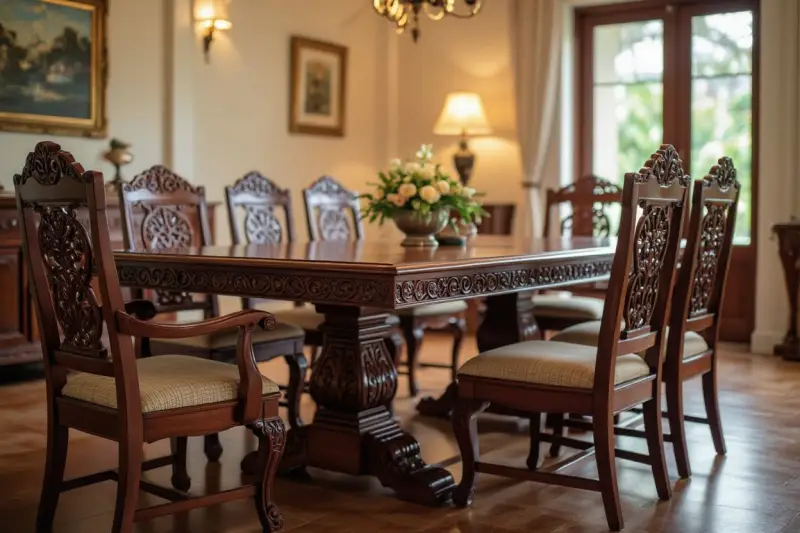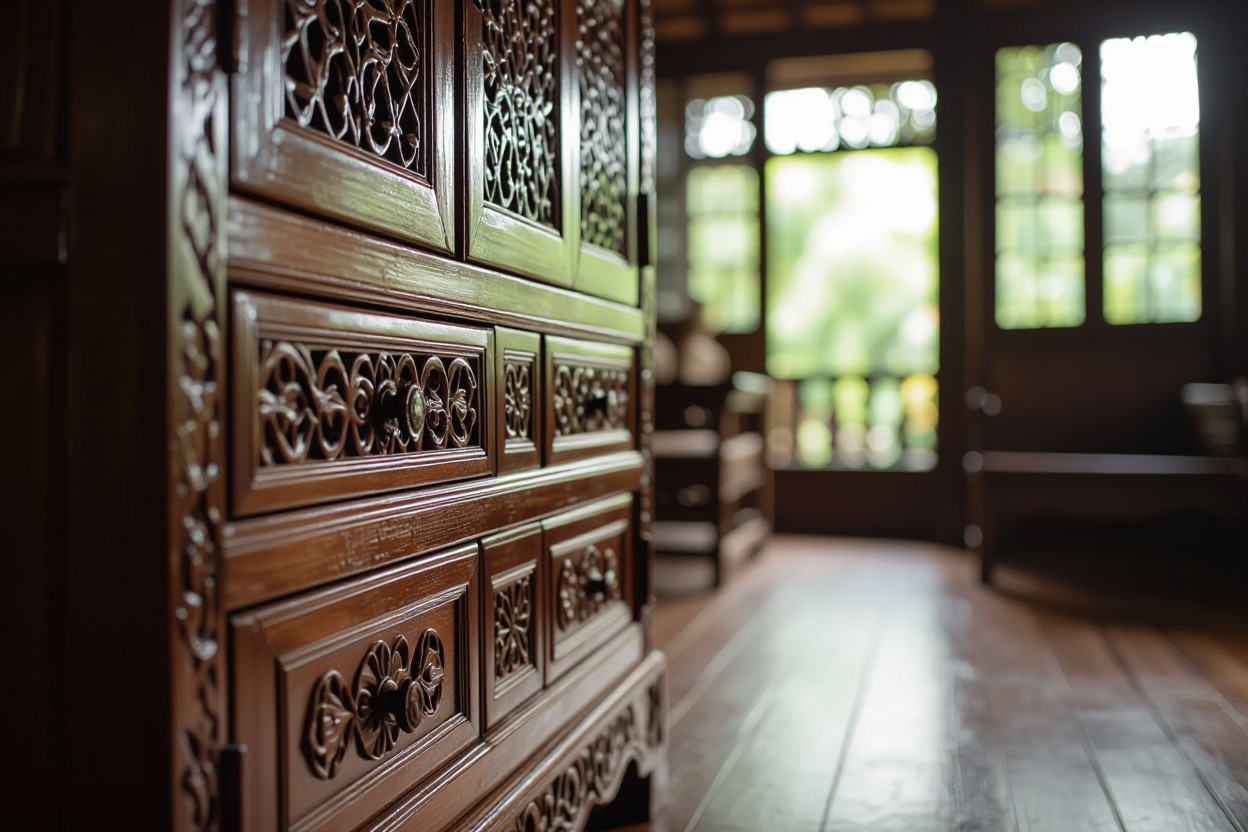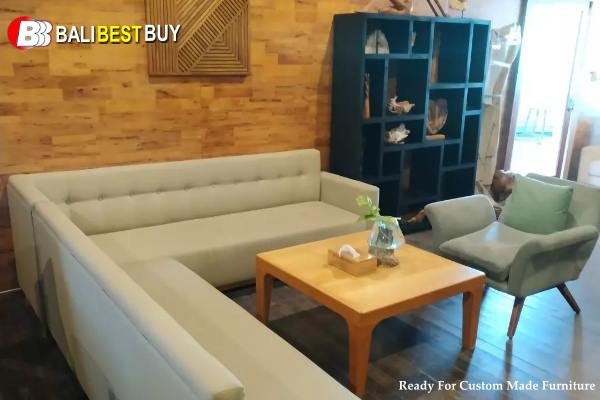Just by choosing Indonesian wooden furniture, you are opting for exceptional craftsmanship and durable materials that can last a lifetime. Your investment supports centuries-old traditions combined with modern design, resulting in pieces that add both character and value to your space. You’ll find that these furnishings not only enhance your home’s beauty but also resist wear, making them a wise choice for lasting elegance. Understanding the artistry and sustainability behind these creations allows you to appreciate why this furniture remains a favorite, offering both functional and aesthetic benefits for generations.

The Craftsmanship Legacy of Indonesian Artisans
Indonesian wooden furniture carries the weight of centuries-old craftsmanship traditions that are deeply woven into the fabric of local culture. As you explore these pieces, you encounter the mastery of artisans who blend ancient techniques with artistic innovation—each creation reflects a commitment to sustainability and authenticity. This legacy ensures that your furniture is not just functional but also a tangible piece of living history, crafted with skill passed down through countless generations.
Generational Skills and Techniques
Families in regions like Jepara and Bali have honed their woodworking skills for over 100 years, preserving methods such as intricate carving and traditional joinery. The knowledge you benefit from includes time-tested practices that avoid nails or screws, ensuring durability and elegance. These techniques, refined through years of practical application and artistic evolution, make your furniture endure not only in strength but in timeless appeal.
The Art of Handcrafted Details
Every curve, pattern, and texture on Indonesian wooden furniture is achieved through painstaking handcrafting. You’ll notice how artisans use chisels, knives, and files to create detailed motifs inspired by nature, mythology, and local folklore, resulting in pieces that stand out for their unique personality and refined aesthetics. This dedication elevates your furniture beyond mass-produced alternatives, providing both artistic and material value.
What sets these handcrafted details apart is the extensive labor and precision involved. For instance, some intricate carvings can take up to 40 hours to complete, with artisans carefully ensuring symmetry and depth to capture light and shadow beautifully. This meticulous attention means that no two pieces are exactly alike—your furniture becomes a singular work of art shaped by human touch and expertise.
Sustainability: The Eco-Friendly Choice
Indonesian wooden furniture offers more than beauty and durability; it aligns with your values for sustainability. Many craftsmen prioritize using materials from forests certified by the Forest Stewardship Council (FSC), ensuring trees are harvested responsibly. This conscious approach helps you support the preservation of Indonesia’s vast biodiversity. Moreover, the natural longevity of teak and mahogany means your furniture reduces the need for frequent replacements, minimizing waste and environmental strain over time.
Responsibly Sourced Materials
You benefit by selecting furniture made from FSC-certified teak or reclaimed wood, which come from well-managed forests or recycled sources. Indonesian producers increasingly avoid illegal logging, focusing on wood sourced exclusively through sustainable plantations. This practice helps maintain healthy ecosystems and supports local communities, so your choice actively promotes environmental stewardship and ethical harvesting.
Low Environmental Impact Production
Production methods used by Indonesian artisans typically minimize waste and energy consumption compared to mass manufacturing. Traditional handcrafting reduces reliance on industrial machinery, cutting down on emissions and chemical use. This means your furniture involves a smaller carbon footprint while preserving centuries-old woodworking techniques, allowing you to own a piece that’s both eco-friendly and culturally rich.
Specifically, many Indonesian workshops incorporate solar energy and water recycling systems, further reducing environmental impact. By using natural oils and finishes derived from plants instead of synthetic chemicals, they protect local waterways and air quality. This detailed attention to sustainable practices ensures the entire lifecycle of your furniture—from tree to finished product—supports ecological balance and lessens harm to surrounding communities.
Aesthetic Versatility: From Traditional to Contemporary
Indonesian wooden furniture seamlessly adapts to a wide range of interior styles, allowing you to express personal taste while maintaining cultural richness. Whether you favor the intricate carvings of traditional Balinese pieces or the clean lines of minimalist teak designs, these items enhance your living space with depth and character. This versatility ensures your investment remains relevant even as your aesthetic preferences evolve, making it an enduring choice for those who value both heritage and modernity.
Integrating with Diverse Design Styles
Wooden furniture from Indonesia fits naturally into a variety of design schemes, from rustic farmhouse to sleek urban lofts. For example, a solid rosewood dining table pairs beautifully with industrial metal chairs, while a carved Javanese bench can add warmth to Scandinavian-inspired interiors. This integration flexibility allows you to curate a unique environment without committing to a single style, ensuring your furniture complements your evolving design vision.
Timeless Appeal in Functionality and Form
The design of Indonesian wooden furniture strikes a balance between elegant form and practical function, guaranteeing long-term utility. You benefit from pieces engineered to endure daily use without sacrificing style, such as the ergonomic curves found in teak lounge chairs or the sturdy joints in mahogany cabinets. This blend of durability and aesthetic sophistication ensures your furniture serves both a practical and decorative role for years to come.
Additionally, many Indonesian wooden items incorporate traditional joinery techniques that negate the need for nails or screws, enhancing structural integrity and longevity. For instance, the mortise-and-tenon joints in Sundanese teak wardrobes not only provide strength but also allow for easy disassembly and transportation. These construction methods contribute to the furniture’s resilience, making it a smart investment that retains its value and beauty while supporting your daily living needs.
Investment Value: Furniture as Timeless Assets
Indonesian wooden furniture stands out as a long-term investment, offering more than mere utility. Crafted from sustainably sourced hardwoods like teak and mahogany, each piece maintains its structural integrity and aesthetic appeal for decades, often becoming family heirlooms. These furnishings not only elevate your living space but also serve as appreciating assets due to their rarity, handcrafted details, and enduring style. By investing in Indonesian wooden furniture, you secure items that defy trends and inflation, safeguarding your wealth through tangible, beautiful craftsmanship.
Appreciation in Value Over Time
Unlike most interior items that lose value, certain Indonesian wooden pieces appreciate, especially antique teak carvings or limited-edition hand-carved items. Their value increases as the wood ages gracefully, gaining rich patina and enhanced character. Collectors and connoisseurs pay premiums for authentic craftsmanship rooted in Indonesian tradition. For example, teak furniture from the early 20th century often commands 30% to 50% higher prices than new imports, highlighting the innate potential for your investment to grow with time.
Low Depreciation Compared to Mass-Produced Alternatives
Mass-produced furniture typically suffers from rapid depreciation due to lower-quality materials and assembly-line manufacturing. Indonesian wooden furniture, created with durable hardwoods and meticulous hand finishing, resists wear and tear much better, ensuring it retains value and function over the years. This durability keeps your investment robust even under daily use, distinguishing your furniture as both valuable and practical.
| Aspect | Comparison |
|---|---|
| Material Quality | Indonesian furniture: Solid teak and mahogany offering longevity; Mass-produced: Engineered wood or particle board prone to damage |
| Craftsmanship | Hand-carved, detailed finishing versus automated, uniform assembly with often weaker joints |
| Longevity | Decades or centuries with proper care; Mass-produced often lasts less than 10 years before noticeable deterioration |
| Market Demand | Consistent demand for authentic Indonesian pieces among collectors and interior designers; limited appeal for mass-produced items once out of style |
Because Indonesian wooden furniture emphasizes quality over quantity, it maintains robust resale value and sustained demand in secondary markets. Its resistance to chipping, warping, and fading means you avoid common depreciation pitfalls affecting cheaper, manufactured products. Consequently, your investment not only lasts but holds market appeal, giving you flexibility and confidence when the time comes to refresh your décor or pass on your collection.

Cultural Heritage and Storytelling Through Furniture
Indonesian wooden furniture embodies more than mere utility; it serves as a canvas preserving centuries of cultural narratives and artisanal mastery. Each meticulously carved piece tells a story that transcends generations, connecting you with rich traditions and ancestral wisdom. When you invest in this furniture, you’re inviting history into your living space, where every motif and shape resonates deeply with the diverse ethnic identities that define Indonesia’s vibrant heritage.
Each Piece’s Unique Cultural Significance
Furniture from regions like Java, Bali, and Sumatra reflects distinct artistic expressions tied to local myths, religious beliefs, and social customs. For example, a Balinese coffee table might showcase elaborate floral carvings symbolizing fertility and prosperity, while Javanese chairs often feature stylized motifs inspired by ancient Hindu epics. Your choice not only elevates your environment aesthetically but also acts as a personalized connection to these nuanced cultural stories.
The Narrative of Indonesian Traditions in Design
Traditional Indonesian designs consistently weave spiritual and symbolic elements into the woodwork, merging function with profound meaning. Motifs like the “kawung” pattern symbolize purity and eternity, and the “gunungan” represents the universe’s balance. By appreciating such intentional design, you own more than furniture—you steward a living piece of Indonesia’s heritage.
Delving deeper, many Indonesian furniture pieces incorporate time-honored woodworking techniques such as “ukir” (intricate carving) and “anyam” (weaving), imparting both texture and symbolic layers. The patterns often tell stories of local folklore or cosmological beliefs integral to the artisan’s community. For example, the gunungan motif, resembling a mountain shape, represents the cosmic axis, linking earthly life to the spiritual realm. This kind of symbolism invites you to explore and honor the profound connections between craftsmanship and cultural identity.
To wrap up
Now that you understand the exceptional craftsmanship, durability, and unique aesthetic appeal of Indonesian wooden furniture, you can truly appreciate why it stands as a timeless investment. When you choose pieces crafted from rich hardwoods like teak or mahogany, you’re not just enhancing your living space; you’re securing furniture that retains its value over time. For the finest selection of high-quality furniture in Bali, consider Bali Best Buy Furniture. As a leading provider of Indonesian furniture right here in Bali, they ensure that your investment in these elegant, handcrafted items combines functionality with cultural heritage, making them a cherished and lasting addition to your home for years to come.


